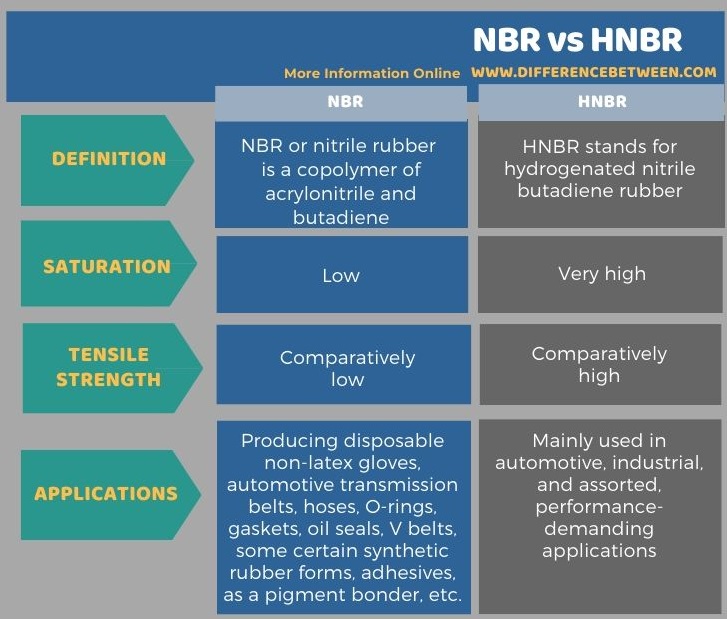Difference Between NBR and HNBR
Table of Contents
The key difference between NBR and HNBR is that NBR is a non-hydrogenated form, whereas HNBR is a hydrogenated form.
NBR is the shortened form of nitrile rubber. HNBR is the hydrogenated form of nitrile rubber. It is a synthetic copolymer of acrylonitrile and butadiene. HNBR or hydrogenated nitrile rubber is widely used due to its physical strength and retention of properties even after the exposure to heat, oil, and chemicals.
CONTENTS
1. Overview and Key Difference
2. What is NBR
3. What is HNBR
4. Side by Side Comparison –NBR vs HNBR in Tabular Form
5. Summary
What is NBR?
NBR or nitrile rubber is a copolymer of acrylonitrile and butadiene. It is a synthetic polymer material. The most common trade names of NBR are Perbunan, Nipol, Krynac, and Europrene. The term NBR stands for nitrile butadiene rubber. This material comes under the family of unsaturated copolymers of 2-propenenitrile. Generally, this polymer material is highly resistant to oil, fuel and many other chemicals.
When considering the production of NBR, the reaction mixture requires an emulsifier, 2-propenenitrile, butadiene monomer, radical generating activators, and a catalyst. The reaction medium for this particular reaction is water. The temperature used in this production process is nearly room temperature or slightly above. This reaction facilitates polymerization and branch formation in the polymer material.
In its raw state, NBR has a yellow colour. Sometimes, it can appear in orange, or as a red-tinted material. Usually, this material shows an excellent resistance towards mineral oil, vegetable oil, benzene, petrol, dilute acids and alkaline solvents. More importantly, the ratio of acrylonitrile groups to butadiene groups in the polymer backbone, referred to as the ACN content, is important in determining the glass transition temperature of this material.

Figure 01: A Disposable Glove Made of NBR
There are many different uses of NBR. For example, producing disposable non-latex gloves, automotive transmission belts, hoses, O-rings, gaskets, oil seals, V belts, some certain synthetic rubber forms, adhesives, as a pigment bonder, etc. are the uses of NBR.
What is HNBR?
The term HNBR stands for hydrogenated nitrile butadiene rubber. It is hence the hydrogenated form of nitrile rubber. This material is also known as highly saturated nitrile, considering the chemical composition of the polymer material. This material is very important due to its favourable properties such as high strength, retention of properties upon exposure to heat, oil, and chemicals.
There are many applications of HNBR. This material is used over NBR due to its high strength. For example, this HNBR material is mainly used in automotive, industrial, and assorted, performance-demanding applications. Most commonly, HNBR is used to manufacture O-rings for automotive air-conditioning systems.
The tensile strength of HNBR typically ranges from 20-31 MPa at low temperature (around 23 degrees Celsius). However, the compounding techniques of HNBR allows it to be used at a wide temperature range. Also, it shows minimal degradation over a long time period. According to the application, the type HNBR used varies. For example, low ACN grades of HNBR are useful for low-temperature applications, while high CAN grades are useful for high-temperature applications.
What is the Difference Between NBR and HNBR?
NBR is an abbreviation of nitrile rubber while HNBR is the hydrogenated form of nitrile rubber. The key difference between NBR and HNBR is that NBR is a non-hydrogenated form, whereas HNBR is a hydrogenated form. Moreover, NBR has a comparatively low tensile strength compared to HNBR.
Below infographic shows more comparisons related to the difference between NBR and HNBR.

Summary – NBR vs HNBR
The term NBR is used to name nitrile rubber. The key difference between NBR and HNBR is that NBR is a non-hydrogenated form, whereas HNBR is a hydrogenated form.
Reference:
1. “Nitrile Rubber.” Wikipedia, Wikimedia Foundation, 4 May 2020, Available here.
Image Courtesy:
1. “Disposable nitrile glove” (Public Domain) via Commons Wikimedia
ncG1vNJzZmivp6x7pbXFn5yrnZ6YsqOx07CcnqZemLyue8OinZ%2Bdopq7pLGMm5ytr5Wau266watkmqaUYrWvrtFo